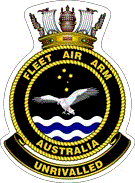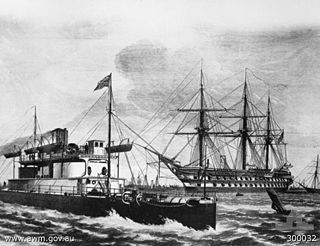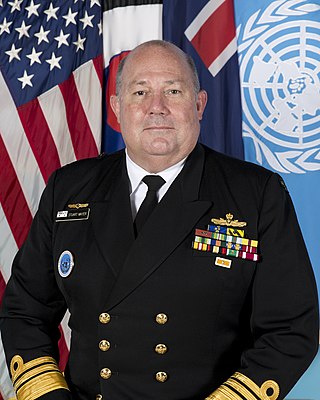Related Research Articles

The Royal Australian Navy (RAN) is the naval force of the Australian Defence Force (ADF). The professional head of the RAN is Chief of Navy (CN) Vice Admiral Mark Hammond AM, RAN. CN is also jointly responsible to the Minister of Defence (MINDEF) and the Chief of Defence Force (CDF). The Department of Defence as part of the Australian Public Service administers the ADF.

The Royal Australian Air Force (RAAF) is the principal air and space force of Australia, a part of the Australian Defence Force (ADF) along with the Royal Australian Navy and the Australian Army. Constitutionally, the Governor-General of Australia, is the de jure Commander-in-Chief of the Australian Defence Force. The Royal Australian Air Force is commanded by the Chief of Air Force (CAF), who is subordinate to the Chief of the Defence Force (CDF). The CAF is also directly responsible to the Minister for Defence, with the Department of Defence administering the ADF and the Air Force.

The Australian Defence Force (ADF) is the military organisation responsible for the defence of the Commonwealth of Australia and its national interests. It consists of the Royal Australian Navy (RAN), Australian Army, Royal Australian Air Force (RAAF) and several "tri-service" units. The ADF has a strength of just over 85,000 full-time personnel and active reservists and is supported by the Department of Defence and several other civilian agencies.

Australia joined a US-led coalition in its 2003 Iraq invasion. Declassified documents reveal that the decision to go to war was taken primarily with a view to enhancing its alliance with the United States.
The military history of Australia spans the nation's 230-year modern history, from the early Australian frontier wars between Aboriginals and Europeans to the ongoing conflicts in Iraq and Afghanistan in the early 21st century. Although this history is short when compared to that of many other nations, Australia has been involved in numerous conflicts and wars, and war and military service have been significant influences on Australian society and national identity, including the Anzac spirit. The relationship between war and Australian society has also been shaped by the enduring themes of Australian strategic culture and its unique security dilemma.

The Fleet Air Arm (FAA), known formerly as the Australian Navy Aviation Group, is the division of the Royal Australian Navy (RAN) responsible for the operation of aircraft. The FAA was founded in 1947 following the purchase of two aircraft carriers from the Royal Navy. FAA personnel fought in the Korean War and the Vietnam War, and participated in later conflicts and operations from host warships.

The Huon-class minehunter coastal (MHC) ships are a group of minehunters built for the Royal Australian Navy (RAN). Following problems with the Bay-class minehunters, a request for tender was issued in 1993 for a class of six coastal minehunters under the project designation SEA 1555. The tender was awarded in 1994 to the partnership of Australian Defence Industries (ADI) and Intermarine SpA, which was offering a variant of the Italian Gaeta-class minehunter.

Before Federation in 1901 five of the six separate colonies maintained their own naval forces for defence. The colonial navies were supported by the ships of the Royal Navy's Australian Station which was established in 1859. The separate colonies maintained control over their respective navies until 1 March 1901, when the Commonwealth Naval Forces was created.

Australia in the War of 1939–1945 is a 22-volume official history series covering Australian involvement in the Second World War. The series was published by the Australian War Memorial between 1952 and 1977, most of the volumes being edited by Gavin Long, who also wrote three volumes and the summary volume The Six Year War.

The Australia Station was the British, and later Australian, naval command responsible for the waters around the Australian continent. Australia Station was under the command of the Commander-in-Chief, Australia Station, whose rank varied over time.
Vice Admiral Sir Roy Russell Dowling, was a senior commander in the Royal Australian Navy (RAN). He served as Chief of Naval Staff (CNS), the RAN's highest-ranking position, from 1955 until 1959, and as Chairman of the Chiefs of Staff Committee (COSC), forerunner of the role of Australia's Chief of the Defence Force, from 1959 until 1961.
The Joint Intelligence Organisation (JIO) was an Australian government intelligence agency that existed between 1969 and 1990 and which was responsible for the analysis of defence and foreign intelligence.

The New Zealand Division of the Royal Navy also known as the New Zealand Station was formed in 1921 and remained in existence until 1941. It was the precursor to the Royal New Zealand Navy. Originally, the Royal Navy was solely responsible for the naval security of New Zealand. The passing of the Naval Defence Act 1913 created the New Zealand Naval Forces as a separate division within the Royal Navy.
Australia in the Korean War 1950–53 is the official history of Australia's involvement in the Korean War. The series consists of two volumes covering Australia's strategy and diplomacy in the war and the Australian military's combat operations respectively. Both volumes were written by Robert O'Neill, and they were published in 1981 and 1985.
Lieutenant (abbreviated Lt, LT (U.S.), LT(USN), Lieut and LEUT, depending on nation) is a commissioned officer rank in many English-speaking nations' navies and coast guards. It is typically the most senior of junior officer ranks. In most navies, the rank's insignia may consist of two medium gold braid stripes, the uppermost stripe featuring an executive curl in many Commonwealth of Nations; or three stripes of equal or unequal width.

Vice Admiral Raymond James Griggs, is an Australian senior public servant and a former senior officer in the Royal Australian Navy. He served as Chief of Navy from June 2011 to June 2014, before being appointed Vice Chief of the Defence Force until his transfer to the reserve in July 2018.
The Department of the Army was an Australian federal government department. Created on 13 November 1939 following the outbreak of the Second World War, it assumed control of the administration and finance of the Australian Army from the Department of Defence. The department was abolished by the Whitlam government on 30 November 1973 when the single service departments were once again amalgamated, with its role assumed by the Army Office within the Department of Defence.
The Department of Air is a former Australian federal government department. Created on 13 November 1939 following the outbreak of the Second World War, it assumed control of the administration and finance of the Royal Australian Air Force (RAAF) from the Department of Defence. Following the war its functions were expanded to include responsibility for air defence as well as the organisation and control of the RAAF. The department was abolished by the Second Whitlam Ministry on 30 November 1973 when the single service departments were once again amalgamated, with its role assumed by the Air Office within the Department of Defence.

Vice Admiral Stuart Campbell Mayer, is a retired senior officer of the Royal Australian Navy. He joined the navy via the Royal Australian Naval College at HMAS Creswell in 1984 and qualified as a Principal Warfare Officer in 1994. He commanded HMAS Canberra (2002–04), HMAS Anzac (2007–09) and the International Stabilisation Force (2009–10), and deployed on operations to the Persian Gulf, East Timor, and the Arabian Sea during the Iraq War. He served as Commander Australian Fleet from 2014 to 2018, Head Force Design within the Vice Chief of Defence Force Group from 2018 to 2019, and Deputy Commander United Nations Command, based in South Korea, from 2019 to 2021. He retired from the navy in 2022 and was appointed a partner in Ernst & Young's consulting division.

The Naval Recruitment Training Agency (NRTA) originally called the Naval Training Department was first established in 1944 as a department within the Admiralty it underwent numerous name changes until 1 April 1995 as a new agency of the Navy Department of the British Ministry of Defence. Its role was to contribute to the operational capability of the United Kingdom Armed Forces by recruiting to the Naval Service, delivering training to the Defence community it was administered by the Chief Executive (NRTA)/Flag Officer, Training and Recruitment it was abolished in 2005.
References
- Dennis, Peter; Grey, Jeffrey; Morris, Ewan; Prior, Robin; Bou, Jean (2008). The Oxford Companion to Australian Military History (Second ed.). Melbourne: Oxford University Press. ISBN 9780195517842.